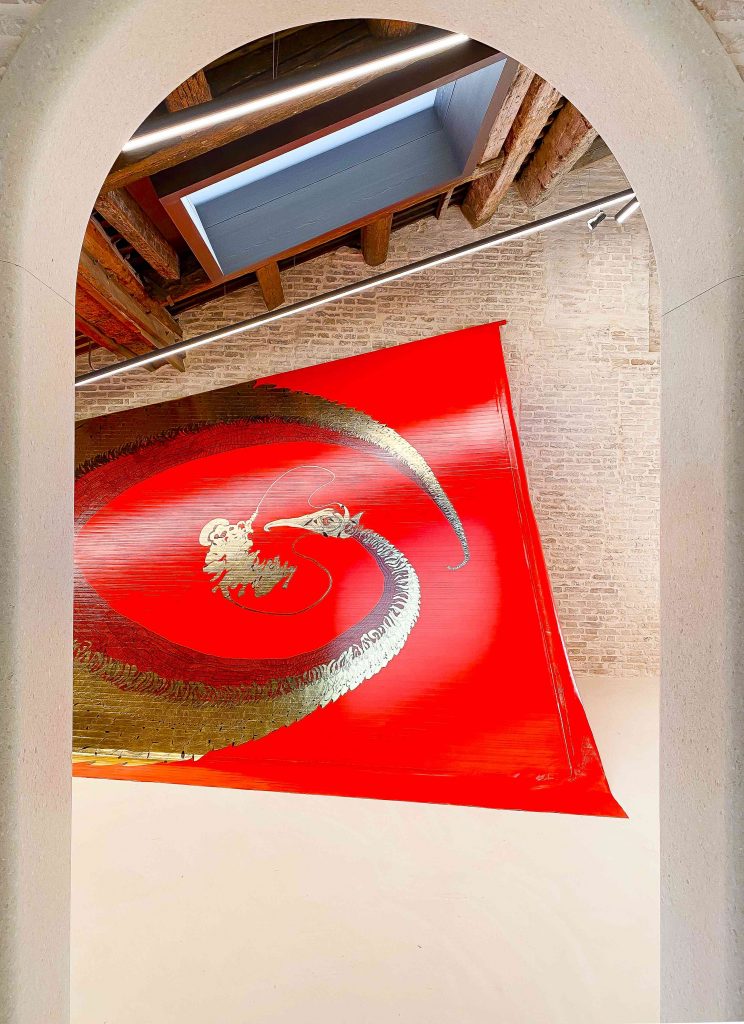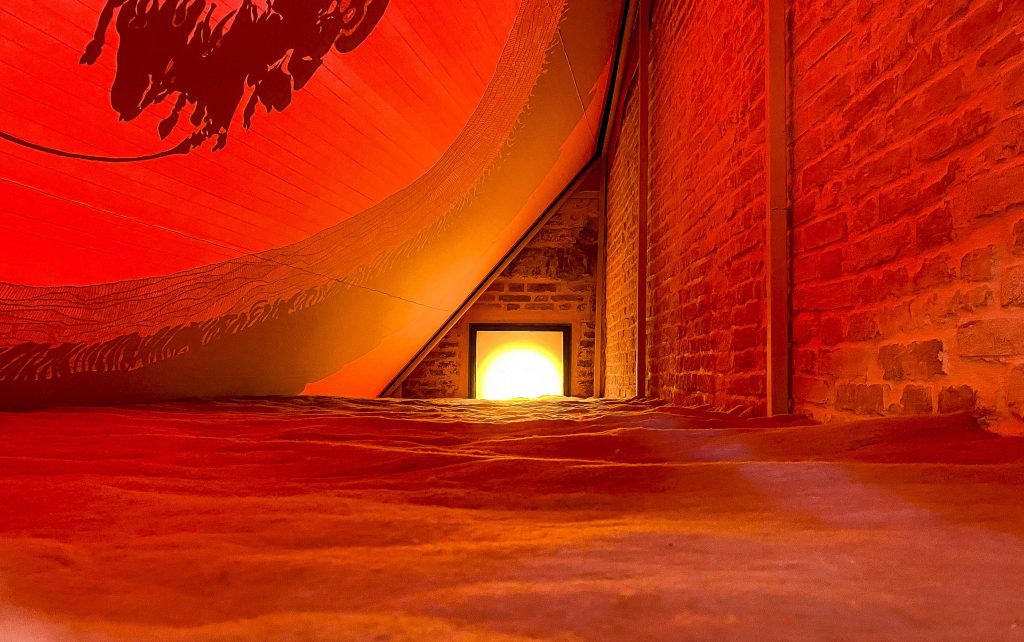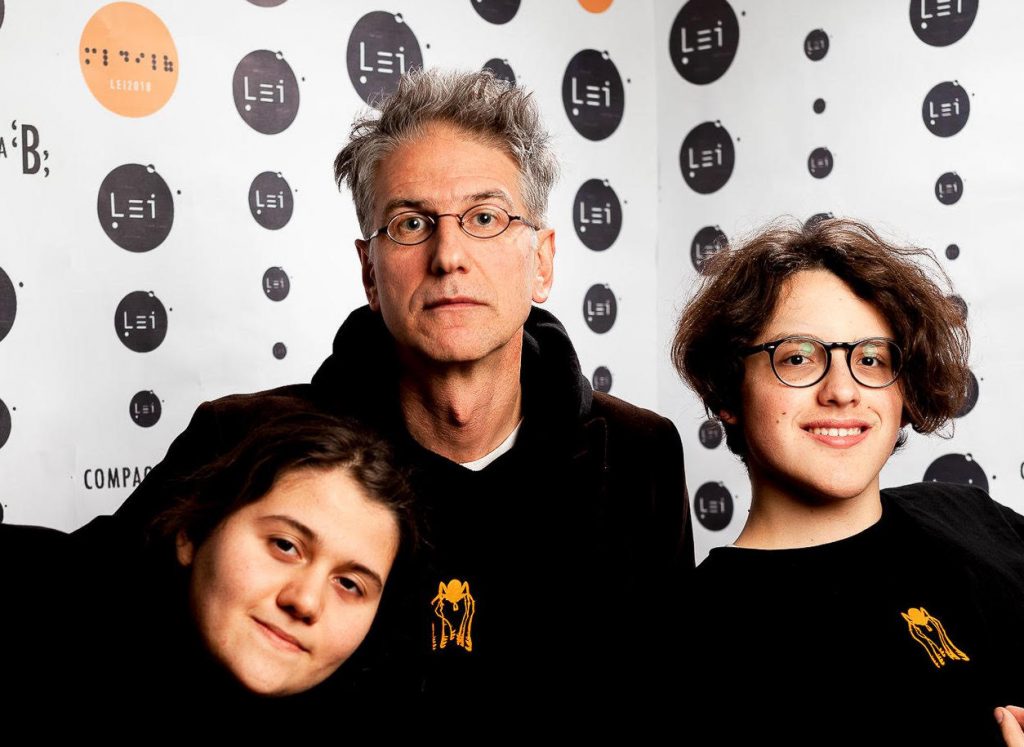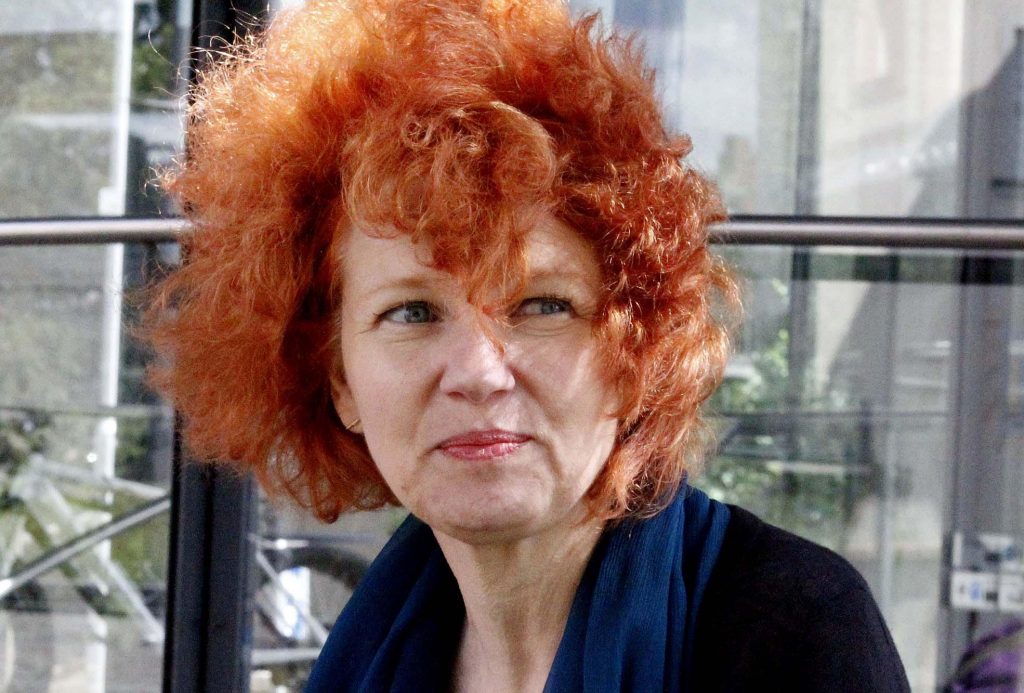ATELIER DELL’ERRORE
Critical Generation: How would you define the Atelier dell’Errore? What is its history and who are its protagonists?
Luca Santiago Mora: We could define the AdE as a small realized utopia, a transformed ‘social sculpture’ that has a problematic nature in social wealth. Atelier dell’Errore BIG (AdE BIG) is an artistic collective dedicated to the visual arts and performance. It was formed in 2015 and set up a social enterprise in 2018. Since its establishment, the AdE BIG has been permanently housed in the Maramotti Collection in Reggio Emilia as a work in progress. AdE BIG originates from the Atelier dell’Errore project, a visual arts laboratory dedicated since 2002 by the visual artist Luca Santiago Mora to the children of infant neuropsychiatry of the Reggio Emilia and Bergamo Hospital and became the Atelier dell’Errore Association in 2011.
GC: Atelier dell’Errore is housed in the spaces of Collezione Maramotti in Reggio Emilia, how was this collaboration born and developed?
LSM: The collaboration with the Maramotti Collection stems from the need of the AdE project to find a physical space outside the health facilities to continue the artistic path with the boys who, after having attended the laboratory for years, becoming of age and automatically switching to psychiatry/adult handicaps, they could no longer continue their experience in the laboratories dedicated to child neuropsychiatry. This collaboration was born at the beginning of 2015 and already after a few months triggers the first public exhibition, called ‘Men as Food’, a sort of counter-Expo, a site specific installation in which the animals that feed on humans of the AdE occupy for 6 months on all 5 floors of an elegant building in via Monte di Pietà in the center of Milan. From this was born the following year the volume “Zoologia profetica” edited by Marco Belpoliti published by Corraini, which serves as a catalog raisonné of the exhibition thanks to the intervention dedicated to the project by 14 important personalities of the Italian artistic and scientific culture. In 2018, with the 10 young people who began to attend the workshop within the collection on a daily basis, it was decided to officially set up the AdE BIG artistic collective where all the young people participating are members-designers and become professionals of contemporary art in all respects. At the same time, the Collection decides to dedicate a large permanent and definitive space to this project on the third floor of the Collection which serves as both a laboratory and an exhibition space for the collective.
GC: In the many years of activity, Atelier dell’Errore has started several collaborations and carried out different projects, from the creation of covers for the Quodlibet publishing house, performances hosted at the Milan Triennale and Arte Sella, drawings on display at the Massimo De Carlo gallery. How do these projects fit into the daily work of the atelier and how are they received by the various stakeholders involved?
LSM: They are collaborations of a very different character. The one with Quodlibet was born within the laboratories of child neuropsychiatry thanks to the mutual esteem with Ermanno Cavazzoni responsible for the Compagnia Extra series, while the performative body of the AdE comes to light thanks to a specific invitation from the Teatro delle Albe of Ravenna that gave us asked in 2017 for a history of the AdE in dramaturgical form. The arrival at the Massimo De Carlo Gallery is different, which is the first exhibition of the AdE aimed at marketing. Needs and will born after the constitution of the artistic collective Ade BIG which, not receiving any public funding, must and wants to deal with the art market tout court in order to meet the budget laws to which every social enterprise is subject. The AdE BIG collective is made up of young people who for 10-15 years have attended the laboratory within the public service and have come of age and have decided that their life can only have meaning if it is dedicated to art.

Atelier dell’Errore BIG. CHUTZPAH a cura di Gabi Scardi | The Art Studio – The Human Safety Net, Procuratie Vecchie, Venezia
GC: On the occasion of the Biennale Arte 2022, the CHUTZPAH project was curated by Gabi Scardi and set up inside the Procuratie Vecchie in Venice. Is this the first time you have entrusted yourself to the figure of a curator?
LSM: The AdE is fundamentally self-sufficient, also by virtue of the versatility of the people who make up the collective itself, this allows us to take care of an artistic project from the initial conception to the final realization. However, in the complexity of a long journey like this, the contribution of a lateral but organic look at the very nature of our work is fundamental. We have a very special relationship with Gabi as she has been following and knowing us for a long time and consequently there is the utmost trust in mutual work. Gabi turned out to be a precious look at our process already on the occasion of “Red Light Gold Light” by Massimo De Carlo therefore we therefore had no doubts in his reconfirmation for Chutzpah.
GC: Curating an exhibition involves different aspects of the work, from a more theoretical design phase, to a relationship with the dedicated space/location, this one of CHUTZPAH seems to have the characteristics of a site-specific work. What was it like working with the AdR group and what kind of actions did you privilege in following the project?
Gabi Scardi: Curating is an activity of coaching and sharing with an artist, in this case with an artistic group; activity that must necessarily be based on a harmony in terms of sensitivity and on a great contiguity with artistic thought; this is even more true when the work arises from radical needs such as those that animate AE. It is natural that a long-term relational commitment can allow a deeper adherence to artistic work and its reasons. And in fact, the beginning of work with AdE dates back to years ago. The relationship has never stopped, on the contrary it has been intensifying. I had followed the origin of the project from a distance. Starting to deal with it with a more direct involvement, as it happened at a certain point, was a natural step. In the case of CHUTZPAH, the work consisted of a dialogue, in a continuous exchange on the meaning, and on the methods of staging, which however in this case were one with the form that the work gradually took. We also imagined a kind of little guide that could introduce the work. We made sure that the Art Studio exhibition was limited in itself and, at the same time, connected to the path on the individual potential of the foundation of The Human Safety Net in Venice, which occupies the rest of the building’s floor. Moreover, the title of the exhibition itself, CHUTZPAH, was also born in reference to that path, with the work of AdE intended as a crowning and personal declination of the value of Courage. Returning to the curatorial work, it was one of intense dialogue, rereading, reflection. Then there was the moment when the concrete details of the installation and presentation became crucial. During the setting up, my relationship with the institution also intensified.
CG: CHUTZPAH is a Yiddish term that indicates impudence but which in everyday use takes on the value of boldness and courage. Why are these two characteristics representative of your mission?
LSM: First of all because Chutzpah was born in Yiddish culture with a decidedly negative meaning but over time it reveals its absolutely precious and positive nature which then takes over. And this is a bit of the miracle of the AdE that arises from working with young people who are experienced as a social problem and then, thanks to the mediation of art and tenacious daily work in the atelier, they reveal a social wealth. Furthermore, there is no doubt that the AdE, having no historical precedents of reference, had to open a personal path within the world of contemporary art, for example by categorically refusing to be locked up in the Irregular/Outsider Art circuit that does not represent it. And to do this, in an ultra-competitive and selective reality such as that of the contemporary art, one must have a certain boldness mixed with the audacity and tenacity that characterize the whole modus operandi of Hades. Even from the executive point of view, the AdE is by definition Chutzpah, as being an anti-academic collective by its nature it has often found itself having to/want to invent its own executive techniques, often going against the opinion of professional technicians who have defined impossible some realizations then completed. And the two site specific works by Chutzpah are the most recent testimony of this. Here, using the definition of ‘technically impossible’ as the trigger for a daring and laborious technical-artistic process is an inherent feature of the AdE.
GC: The relationship with artists and not only with their works also involves a personal, intimate and human side that plays an important role. When the artist is not one but is a collective, the dynamics can be even more complex and layered. What were the cornerstones of your work on the occasion of Chutzpah, between client and site-specific?
GS: In the case of AEs it is also important to understand the specific characteristics of the group, its modalities and its internal balances, its dynamics towards the “outside world”, including its limits. While as regards the question of space, this work was born under a suggestion from Generali by considering the specific situation of the Procuratie in Piazza San Marco, already site-specific in itself. This happens quite often in the case with AdE. During the setting up phase, it was necessary to work on some details, however important, for which we have identified “creative” solutions; this was the case, for example, of the spacers created for Tenda Mater.

Atelier dell’Errore BIG. CHUTZPAH a cura di Gabi Scardi | The Art Studio – The Human Safety Net, Procuratie Vecchie, Venezia
GC: In the planning a phase, how do the young people who take part in the various initiatives demonstrate their involvement and how much space for action and planning is reserved for them? What are the critical issues, if any?
LSM: AdE BIG has revealed itself over time as a real contemporary Renaissance laboratory where each of the students, depending on the project to be tackled, is able and knows how to find their own specific technical specialist that allows them to complete the artistic projects that come to us. The works of AdE are always collective works in the strictest and most literal sense of the term as each drawing, each sculpture, each installation are the patient and tenacious fruit of the shoulder-to-shoulder, hand-to-hand work of all the guys in the Collective. The artistic direction has the task of building a ‘frame’ (conceptual, theoretical and design) according to the language of the contemporary that allows the precious vision of the youngsters to emerge and be read correctly. The difficulty, as in the case of Chutzpah, lies in translating the objectives of the project to create the magical trigger that starts the imaginative and visionary process of the AdE into a language that is their own and understandable by the guys in the collective.
GC: Chutzpah’s work like other installations sees a direct relationship with the work of art that can be rediscovered through gesture and interaction. I also think of the experience of 2019 at the Maramotti Collection in which in addition to the exhibition of photographic prints, some young people activated the exhibition path with a series of performances. How are these types of interventions born?
LSM: AdE BIG proceeds according to the canon of bricolage (Levi-Strauss), that is, it is done with what you have. The artistic direction of the collective, who perfectly knows the potential of the guys in the collective, has the task of directing the process towards forms, techniques, expressive and executive methods that enhance its urgency, originality and authenticity. For example, AdE presents itself with its own performance body not for a generic à la page ambition, but simply because at the moment at least two of the guys who are part of the collective, express themselves to their maximum potential only through the meeting with the public, the leap into the void of performance. Without them we would not have the current performative need of our collective.
GC: Atelier dell’Erore proposes an unconventional and expanded approach to art. In looking for design solutions in which to include the guys who are part of the atelier, how did you let yourself be guided? Were there any meetings or people who played a decisive role in the direction of the various projects?
LSM: AdE BIG is a very contagious virus and often leads to irreversible mutual affections. The extreme effort and the countless difficulties that are faced every day to carry out a project like this for twenty years, are rewarded by the many people who have become attached to our project and who with their enthusiasm and their trust are propellant to this experience. Impossible to mention all the people to whom the project is indebted without forgetting. There are so many and our great gratitude goes to all of them. I would say that for everyday life and continuity it is impossible not to remember the importance of the Maramotti Collection and of those who are part of it.
GC: Considering the different experiences and the different projects, it could be very interesting to document the activities of AdR, a sort of ‘catalog’ but perhaps it would be too compressed in a video form … there may be spaces, from your point of view as a curator, for a meta-work that documents and involves the group at the same time, respecting their way of working?
GS: Thought exists; but AdE is far from a documentary and didactic spirit. A story of work and its generative processes will only be possible on the basis of a poetic gaze, and it is still difficult to predict what form it will have.
GC: Are you working on new projects? What are the future challenges of Atelier dell’errore?
LSM: The new AdE BIG projects for 2022 are a bi-solo show with Chiara Camoni at the GAM in Turin curated by Elena Volpato which will inaugurate with Artissima and a large permanent work designed and under construction for Palazzo Torlonia in Rome.
18/08/2022

Luca Santiago Mora – Portrait

Gabi Scardi, Portrait

